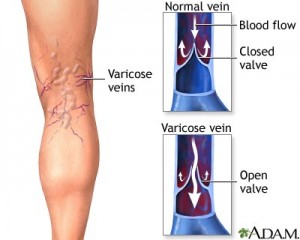Varicose veins is about as recognizable as you see it, with the bulging stream of nerves visible on the skin especially the legs.
A visit to the dermatologist or a vascular surgeon will confirm the suspicions. The following symptoms and signs that you need to consider are:
*** If you can see blue and swollen veins under the skin which is visually obvious.
*** Legs aching.
*** Muscle cramping.
***Itching around bulging veins.
***Skin ulcers (occasionally).
***More pain felt on sitting or standing for long period.
A good explanation why the above is happening has been clearly demonstrated by an English anatomist that the veins have valves. Veins have to work against gravity when blood returns to the heart. In order to that, valves shut as the blood flow heart wards.
In varicose veins, the valves malfunctioned. Instead of steadily bringing back to the heart, incompetent valves let some blood pool in the superficial veins. These appear as the familiar and unsightly “worms” under the skin, usually the legs.
The risk factor group are those groups who are genetically predisposed to varicose vein as a family tradition, this can show up as early as thirty years of age. Obese people usually has it because of the extreme pressure exerted on their legs.
Females in particular because of some female hormones relax veins and pregnant women add pressure to their legs. Occupational demand that requires more of standing like flight attendants, nurses, escort is as well is at risk.
There are various ways to treat varicose veins. a) Some women make it a point to lie down and park their legs against the wall. b) Some women wear compression stockings to squeeze the legs. c) When the aforementioned doesn’t work consider sclerotherapy.
This involve the injection of a chemical (sclerosant) that scars the veins and effectively sealing them. d) Laser surgery – concentrated bursts of lights are fried to close off a vein. e) Vein stripping and ligation – in which the surgeon will expose the vein and either remove it or tie it off.
Varicose veins are easy to diagnose, difficult to treat but possible to prevent. Brisk walking improves legs circulation and will force muscles to pump away the relative stasis in the veins. If you are obese, lose weight and women if possible avoid high heels; these put a lot of strain on the legs.
